
Migrations paths towards an Industrie 4.0 company
© Lehrstuhl für Produktionssysteme, Ruhr-Universität Bochum
What were the challenges to be solved and what specific benefits were achieved?
In today’s business situations that are observing customer’s constantly rising demands for products with shorter delivery periods, a long-term planning is no longer possible. Both internal and external suppliers are now facing requirements that they can no longer meet because companies‘ divisions of technology, organization and staff are not geared up for this. In view of these developments and challenges, the businesses involved have discovered the huge benefits of CPPS; however, they need outside assistance as well as a systematic procedure to master the migration needed for this purpose.
The primary aim of ADAPTION is to support companies to identify and follow their own migration paths to reach a higher CPPS maturity. This involves a paradigm shift from a resource-driven to a product-driven planning. This shift is expected to occur as part of the fourth industrial revolution.
”With the research project ADAPTION, the Chair of Production Systems (LPS) wishes to support small and medium-sized companies (SMEs) on their own way within the increasingly complex industrial landscape affected by the idea of Industrie 4.0”, says Prof. Dieter Kreimeier, LPS academic director. ”It is particularly important to consider this project as a socio-technical system instead of exclusively focusing on technical aspects.”
How can the Industrie 4.0 approach be described?
The problem-solving approach introduces a maturity model which makes it possible to classify the ongoing implementation of CPS (cyber-physical systems) within production processes. This is guaranteed by evaluation guidelines as part of an Industrie 4.0 audit. Aiming at a generally high economic efficiency, a structured migration model serves to derive implementation concepts which help select suitable measures to advance the company units of organization, technology and staff towards CPPS.
What could be achieved?
As there has as yet been no official kick-off of this project, there have not been any significant results yet.
What measures have been taken to achieve the solution?
The solution approach of the project ADAPTION is to thoroughly consider different corporate sectors in terms of the paradigm shift from the resource orientation towards a product orientation. Changes within the areas of technology, organization and staff are essential for companies, especially SMEs, to successfully migrate towards CPPS. In order to investigate these three areas in consideration of the migration towards a cyber-physical production system, the industrial partners (Festo AG & Co. KG, Bernhard und Reiner GmbH, Jacobi Eloxal GmbH) are prepared to provide pilot areas with exemplary application scenarios. The focus will be on the process planning and control within manufacturing processes of prototypes and single and small batch series. Value-added networks are taken into close consideration.
What can others learn from it?
The Chair of Production Systems will incorporate the results regarding the CPPS migration into their own learning factory. Based on the results of the current Industrie 4.0 projects and a software learning platform, a new “Learning Factory Industrie 4.0” will be established to prepare students and businesses for the future changes in the divisions of technology, organization and staff as well as for the migration towards CPPS. As soon as the project is in full progress, the LPS expects to find new research questions which will be investigated within further joint projects. Moreover, the Chair is prepared to regularly publish current results of research works in national and international expert journals.




